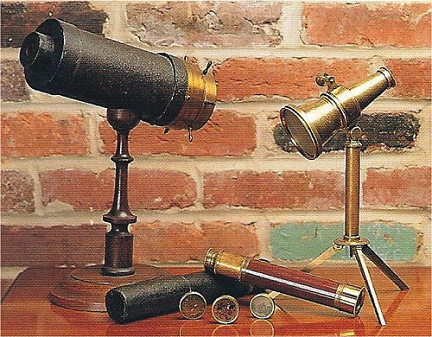 |
| David Brewster, a Scottish physicist, patented the kaleidoscope in 1817. |
Evidence shows that pieces of polished obsidian (a volcanic glass) were used as mirrors as long as 8,000 years ago [source: Enoch]. Mirrors reflected sunlight or fire in early lighthouses, and there's a record of a possible optical illusion by an ancient Egyptian magician involving a mirror. By the 17th century, the "Hall of Mirrors" -- an ornate corridor with 357 mirrors -- in the Palace of Versailles became a display of French glory. Mirrors also may have helped achieve symmetry in planning ornamental gardens, a step in the direction toward the kaleidoscope.
By the early 19th century, the stage was set for this new device that turned utilitarian mirrors into fun. In the early 1800s, scientists were exploring concepts of light and optics, while improving technologies also allowed the middle classes to devote more time and resources to leisure activities. Devices known as philosophical toys became a form of amusement that did double duty by sharing scientific advances while entertaining the masses.
 In 1816, Scotsman Dr. David Brewster was the first to arrange mirrors and objects in a tube and call it a kaleidoscope. Not just a toy, the device also was intended for use by designers and artists, who might be inspired by the beautiful patterns they could create. Brewster patented his invention in 1817.
In 1816, Scotsman Dr. David Brewster was the first to arrange mirrors and objects in a tube and call it a kaleidoscope. Not just a toy, the device also was intended for use by designers and artists, who might be inspired by the beautiful patterns they could create. Brewster patented his invention in 1817.
Kaleidoscope technology made its next leap forward in 1873. That's when American Charles Bush patented several improvements. He added a stand that could be easily disassembled for portability and a rotating wheel to expand the variety of possible designs. Perhaps Bush's most ingenious advance, though, came in the form of special ampoules. An ampoule is a small, sealed glass vial often holding medicine. Tiny ampoules already had been used as objects in some kaleidoscopes. Bush's patent specified ampules with "two or more liquids of different densities or character, or a liquid with a solid or solids." Bush wrote that the liquids within the ampoules should be unable to mix and each would have its own color. This allowed for even more intricate designs [source: Bush].
Today, the society lists about 125 kaleidoscope artists among its members. They're busily turning the philosophical toys into unique art. On the next page, we'll take a look at the wide range of materials and types of kaleidoscopes available today. You'll see that kaleidoscopes have come a long way in 200 years.
No hay comentarios.:
Publicar un comentario